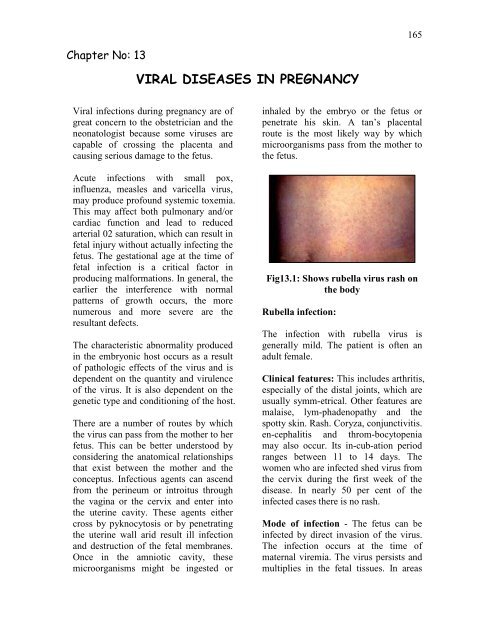Book of Medical Disorders in Pregnancy - Tintash
Book of Medical Disorders in Pregnancy - Tintash
Book of Medical Disorders in Pregnancy - Tintash
Create successful ePaper yourself
Turn your PDF publications into a flip-book with our unique Google optimized e-Paper software.
Chapter No: 13<br />
VIRAL DISEASES IN PREGNANCY<br />
Viral <strong>in</strong>fections dur<strong>in</strong>g pregnancy are <strong>of</strong><br />
great concern to the obstetrician and the<br />
neonatologist because some viruses are<br />
capable <strong>of</strong> cross<strong>in</strong>g the placenta and<br />
caus<strong>in</strong>g serious damage to the fetus.<br />
Acute <strong>in</strong>fections with small pox,<br />
<strong>in</strong>fluenza, measles and varicella virus,<br />
may produce pr<strong>of</strong>ound systemic toxemia.<br />
This may affect both pulmonary and/or<br />
cardiac function and lead to reduced<br />
arterial 02 saturation, which can result <strong>in</strong><br />
fetal <strong>in</strong>jury without actually <strong>in</strong>fect<strong>in</strong>g the<br />
fetus. The gestational age at the time <strong>of</strong><br />
fetal <strong>in</strong>fection is a critical factor <strong>in</strong><br />
produc<strong>in</strong>g malformations. In general, the<br />
earlier the <strong>in</strong>terference with normal<br />
patterns <strong>of</strong> growth occurs, the more<br />
numerous and more severe are the<br />
resultant defects.<br />
The characteristic abnormality produced<br />
<strong>in</strong> the embryonic host occurs as a result<br />
<strong>of</strong> pathologic effects <strong>of</strong> the virus and is<br />
dependent on the quantity and virulence<br />
<strong>of</strong> the virus. It is also dependent on the<br />
genetic type and condition<strong>in</strong>g <strong>of</strong> the host.<br />
There are a number <strong>of</strong> routes by which<br />
the virus can pass from the mother to her<br />
fetus. This can be better understood by<br />
consider<strong>in</strong>g the anatomical relationships<br />
that exist between the mother and the<br />
conceptus. Infectious agents can ascend<br />
from the per<strong>in</strong>eum or <strong>in</strong>troitus through<br />
the vag<strong>in</strong>a or the cervix and enter <strong>in</strong>to<br />
the uter<strong>in</strong>e cavity. These agents either<br />
cross by pyknocytosis or by penetrat<strong>in</strong>g<br />
the uter<strong>in</strong>e wall arid result ill <strong>in</strong>fection<br />
and destruction <strong>of</strong> the fetal membranes.<br />
Once <strong>in</strong> the amniotic cavity, these<br />
microorganisms might be <strong>in</strong>gested or<br />
165<br />
<strong>in</strong>haled by the embryo or the fetus or<br />
penetrate his sk<strong>in</strong>. A tan’s placental<br />
route is the most likely way by which<br />
microorganisms pass from the mother to<br />
the fetus.<br />
Fig13.1: Shows rubella virus rash on<br />
the body<br />
Rubella <strong>in</strong>fection:<br />
The <strong>in</strong>fection with rubella virus is<br />
generally mild. The patient is <strong>of</strong>ten an<br />
adult female.<br />
Cl<strong>in</strong>ical features: This <strong>in</strong>cludes arthritis,<br />
especially <strong>of</strong> the distal jo<strong>in</strong>ts, which are<br />
usually symm-etrical. Other features are<br />
malaise, lym-phadenopathy and the<br />
spotty sk<strong>in</strong>. Rash. Coryza, conjunctivitis.<br />
en-cephalitis and throm-bocytopenia<br />
may also occur. Its <strong>in</strong>-cub-ation period<br />
ranges between 11 to 14 days. The<br />
women who are <strong>in</strong>fected shed virus from<br />
the cervix dur<strong>in</strong>g the first week <strong>of</strong> the<br />
disease. In nearly 50 per cent <strong>of</strong> the<br />
<strong>in</strong>fected cases there is no rash.<br />
Mode <strong>of</strong> <strong>in</strong>fection - The fetus can be<br />
<strong>in</strong>fected by direct <strong>in</strong>vasion <strong>of</strong> the virus.<br />
The <strong>in</strong>fection occurs at the time <strong>of</strong><br />
maternal viremia. The virus persists and<br />
multiplies <strong>in</strong> the fetal tissues. In areas


